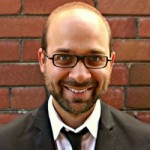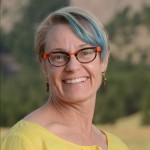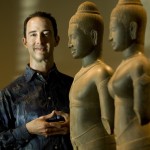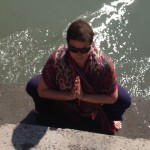Fatemah Alzubairi
Fatemah Alzubairi is a PhD candidate at Osgoode Hall Law School. Her thesis is on counter-terrorism and national security in the Arab world. In her work, she questions the definition of terrorism and the social interaction with the psychological element of fear. Between 2005 and 2008, she worked as a lawyer in the Committee of Human Rights at the National Assembly of Kuwait where she dealt with cases on torture and ethics.
Abstract
"Creating a Safer World between Law and the Human Mind"
Since 9/11, we have been witnessing an emergence of what I call a “heroic” state. In the field of inter/national security, the primary concern of the heroic state is protecting identity that is based on persona and physical bodies. This state reflects Thomas Hobbes’s state of nature. Hobbes argues that a human does not only seek to avoid death in the present moment, but also to ‘secure himself against the evil he fears’ in the future. This view that is widely accepted in the modern legal systems misses the point that these two fears are significantly different, in which the first deals with actual challenges, whereas the second deals with internal emotions rooted in the conditioned human psyche. Both, however, are forms of avoiding the unknown and at some level denying mortality. I argue that this denial led humanity to be attached to identify the source of threat, whether potential or imaginary, and this urge made fear the dominant of our reality. This paper is an attempt to bridge the gap between law and spirituality through examining the role of the human mind in both creating fear and overcoming it as a first step to manifest a safer world.
Bita Amani
 Bita Amani, B.A. (York U., with distinction), LL.B. (Osgoode Hall Law School), S.J.D. (U. of Toronto), Associate Professor at Queen’s University, Faculty of Law and Co-Director of Feminist Legal Studies Queen’s, teaches courses in intellectual property, information privacy, and feminist legal studies. Dr. Amani is an Adjunct Professor at Osgoode Hall Law School; was a Distinguished Visiting Scholar at Osgoode’s Institute for Feminist Legal Studies (2009-10); a researcher and guest lecturer at Oxford University Intellectual Property Research Centre (2008) and at Leed’s University School of Law, Centre for International Governance (2008); and a research fellow on stay with the Brocher Foundation in Geneva, Switzerland (2008). She has been policy consultant on a range of matters to different levels of government; annotations editor and consultant to the E-Laws Project, and a legislative drafter for the Ministry of the Attorney General, Office of the Legislative Counsel (37th Legislature’s Session, Ontario 2001). She is called to the Bar of Ontario.
Bita Amani, B.A. (York U., with distinction), LL.B. (Osgoode Hall Law School), S.J.D. (U. of Toronto), Associate Professor at Queen’s University, Faculty of Law and Co-Director of Feminist Legal Studies Queen’s, teaches courses in intellectual property, information privacy, and feminist legal studies. Dr. Amani is an Adjunct Professor at Osgoode Hall Law School; was a Distinguished Visiting Scholar at Osgoode’s Institute for Feminist Legal Studies (2009-10); a researcher and guest lecturer at Oxford University Intellectual Property Research Centre (2008) and at Leed’s University School of Law, Centre for International Governance (2008); and a research fellow on stay with the Brocher Foundation in Geneva, Switzerland (2008). She has been policy consultant on a range of matters to different levels of government; annotations editor and consultant to the E-Laws Project, and a legislative drafter for the Ministry of the Attorney General, Office of the Legislative Counsel (37th Legislature’s Session, Ontario 2001). She is called to the Bar of Ontario.
Abstract
"Biopatenting and Industrial Policy Discourse: Decoding The Message of Biomedia on The Limits of Agents and Audiences"
Patent law has yet to recognize the agency and labour of multiple creators acting jointly and in collaboration with so-called inventors. The biotechnology industry operates on the romantic myth and tropes of individual creation, ignoring the agency of plants, animals, people and their genetic substrates. Invention is, according to the law, a singular deliberative act completed in isolation. The legal doctrine of “products of nature” provides only a partial solution against the legitimacy of biopatent claims and is eternally contingent on human agency for representation and meaning. In Canada, the Supreme Court has recognized the agency of non-humans with the concern over “reproducibility” of mice in the Harvard mouse case and used this understanding to inform its reasons against the patentability of the onco-mouse. The court’s decision was highly criticized but perhaps wrongly so. A socio-cultural approach to the law using actor network theory may be instructive for our understanding of biology and biotechnology as discourse, always in performativity, adaptation, mutation, articulation, and translation. It may foster a moral economy by which to challenge the normative assumptions implicit in the claim of legal entitlement to patent rights in a language familiar to the patent bar, paving the way for recognition of the labour, actions, and agency of others while helping to define the necessary limits on patentability and patent rights in biomedia. A multidisciplinary approach may generate the necessary conceptual shift to examining biopatent claims and may create, in the words of Stuart Hall, a critical “moment of collective self-clarification.”
Amélie Barras
Amélie Barras is Assistant Professor in the Law and Society program at York University. She holds a PhD (2011) and MSc (2003) from the London School of Economics and Political Sciences and a BA (2002) from McGill University in Political Science & Anthropology. Her research interests include the politics of secularism and religious freedom; religion & politics; religion & law; religious minorities in western societies; Middle East and Turkish politics; gender studies; feminist methodology; and religion & gender.
Co-author of “Disciplining the Secular Narrative in (Un)usual Places: From Circumcision to Yoga” (with Dia Dabby, see Dia’s profile for abstract)
Faisal Bhabha (CO-CHAIR)

Faisal Bhabha, Assistant Professor at Osgoode Hall Law School, has researched and published in the areas of constitutional law, human rights, multiculturalism, national security and access to justice. Previously, he sat as Vice-chair of the Human Rights Tribunal of Ontario.
He holds an LLM from Harvard Law School, and has lived and researched in South Africa and the Middle East. His research interests include diversity in legal education; ethics and legal professionalism; constitutional law and human rights; and legal pluralism. He teaches in the areas of law and social change and professional ethics and responsibility. He also directs the mooting program and is active in many of the Law School’s clinical and experiential education programs.
Prior to entering academia, Professor Bhabha carried on a varied public and private law practice, appearing before administrative boards and tribunals and at all levels of court, including the Supreme Court of Canada. He also advised or represented numerous public interest organizations and NGOs in matters related to constitutional law and human rights. He has served as a member of the Equity Advisory Group of the Law Society of Upper Canada and has been involved in a number of local and international justice initiatives.
Daniel Blais
Daniel Blais is first year MA sociology student currently attending York University. Daniel completed his undergrad at St. Thomas University in Fredericton, NB, with an honours in sociology, and a major in the interdisciplinary ‘Great Ideas’ program. Daniel has also been an amateur beatboxer and b-boy for the last 10 years, competing, performing and learning across Canada.
Abstract
“Curatorial Discourse of B-Boying Performance and Competing Judging Frameworks”
In b-boying dance competitions around the globe, several different judging systems are presently in use. This paper uses twelve months of fieldwork data, eight semi-structured interviews with well-respected members of the international dance community, as well as narratives of members’ recorded talk from video and online sources, to discuss the discursive construction of a new trend in judging. This trend marks an attempt to transition from the traditional, subjective system, in which a panel of experts decide a winner after a b-boying competition, to more “objective”, mathematically-based judging systems favoured by corporate and government sponsors. In such systems, audiences view the judges’ decisions in real-time after every dancer’s round. My findings illuminate a conflict between two discourses about how b-boying ought to be conceptualized and performed. In one, b-boying is positioned as an art form grounded in a cultural tradition facilitating self-expression and self-healing, and the corporate sponsors whom the new judging systems attract can be decried for appropriating this art form and exploiting its dancers. In the second discourse, the professionalization of b-boy judging and dance, corporate sponsorship, and the development of associations and professional leagues are all positioned as preconditions of the art form’s evolution. Despite their differences, representatives of both side of the art vs sport debate can be seen to position themselves morally and discursively as curators of the dance form, striving to maintain authenticity to its street dance origins while presenting it on ever-larger stages to the everyday layperson.
Cindy Blažević
Cindy Blažević is a Toronto-based visual artist who uses photography and photographic processes to document shifting social and political landscapes. Her images, archival collections and installations explore themes of identity, authority and universality of experience, blending oral history with visual expression. Collaborative and participative processes are key to her practice.
Ms. Blažević has exhibited and/or published both in Canada and Europe. The Canada Council for the Arts, Ontario Arts Council, the British Arts Council, the European Cultural Fund, the Open Society Institute and the Toronto Arts Council have all supported her projects. For more on her past projects, see http://cindyblazevic.com.
Ms. Blažević was the inaugural Artist in Residence at Osgoode Hall Law School for the 2013/14 academic year. Her exhibition, Through A Penal System, Darkly: Criminal Justice Through the Lens of Kingston Penitentiary, will be unveiled at Osgoode in August 2015.
Abstract
Workshop: “Law and the Exquisite Corpse”
Invented by surrealists in the 1920s and played often by me as a child, Exquisite Corpse is a method by which a collection of words (or images) is collectively assembled. Typically, each collaborator adds to a composition in sequence on a sheet of paper – either by following a rule (Adjective-noun-adverb-verb) or by being allowed to see only the end of what the previous person contributed – then folds it to conceal part of the writing, and passes it to the next collaborator for a further contribution.
In this workshop, we'll be using the Exquisite Corpse process to explore narratives of the Canadian justice system. Together we'll collectively play with the photographs, words and concepts from my residency at Osgoode. Perhaps we'll even engage in a thoughtful exchange on what it means to curate knowledge and how curating our experiences of art, of the law and of narratives contextualizes and influences our understanding of society.
Marcia Brennan

Marcia Brennan is Professor of Art History and Religious Studies at Rice University in Houston, Texas. Her research engages modern and contemporary art history and museum studies; mysticism and comparative religion; and the medical humanities. She is the author of several scholarly books, including Curating Consciousness: Mysticism and the Modern Museum (MIT Press, 2010). In addition, she serves as an Artist In Residence in the Department of Palliative Medicine at the M. D. Anderson Cancer Center in Houston. Her experiences in this clinical setting represent the subject of two book projects, including The Heart of the Hereafter: Love Stories from the End of Life (John Hunt Book, U.K., 2014) and Words Beyond Words: Finding Language at the End of Life (forthcoming from Intellect Books, U.K.).
Abstract
"Seeing Only Beauty When There’s Nothing Left to See: Applied Aesthetics and (End of) Life Experience”
Aesthetics can offer an innovative means to address issues of human suffering, while helping to enhance the visibility of vulnerable, and otherwise invisible, populations. In this presentation, I will discuss my experiences as an Artist In Residence in the Department of Palliative Care and Rehabilitation Medicine at the University of Texas M. D. Anderson Cancer Center. Working as a creative writer, I assist individuals at the very end of life in producing meaningful—and often, highly poetic—narratives that express their insights and experiences. Notably, such visions do not tend to be about death, but about life itself. No matter how much or how little a story contains, there is a sense of the “always more,” of a presence that extends beyond the presence of the representation. Such imagery can help to expand our vision of both the end of life, and of life itself, just as it evokes a beauty that survives when all else falls away.
Charles L. Briggs

Charles L. Briggs is the Alan Dundes Distinguished Professor in the Department of Anthropology of the University of California, Berkeley. His publications include Learning How to Ask, Voices of Modernity (with Richard Bauman), Stories in the Time of Cholera (with Clara Mantini-Briggs), and Poéticas de vida en espacios de muerte. He is currently researching narrative representations of violence; global health and indigenous knowledge practices; cultural models of mobility, circulation, and communication; and, in Cuba, Venezuela, and the United States, how media representations shape the politics of health.
Abstract
"Biomediatized Bodies: Co-producing Difference through Medical-Media Entanglements”
This paper traces one of the most ubiquitous, dispersed, and consequential yet virtually unexplored (in scholarly terms) sites in which inequalities between bodies and associated subject-positions are constructed. It examines a key point where two contemporary processes come together: biomedicalization, the interpenetration of biomedicine with other social structures, the increasing role of science, medicine and technology in diverse areas of daily life, and the internalization of this process in identities and modes of self-construction, and mediatisation, the transformation that takes place as media become increasingly central to more and more areas of social life. Complex linkages between medical and media logics, practices, and professionals produce a proliferation of news coverage of health on the Internet and in social media as much as in "the traditional media," one that is produced as health professionals populate media institutions, even as journalists are employed by clinics, hospitals, HMOs, public health departments, and biotech and pharmaceutical corporations. Here I focus on the complex ways that news coverage (de)racializes bodies, particularly as projections of cultural difference are mustered in naturalizing inequalities in access to health care (in the United States, that is) and unequal distributions of death and disease.
Shawn Brixey

Shawn Brixey is Dean of the School of the Arts, Media, Performance & Design at York University. A creative artist, researcher and inventor working at the interface of art, science and technology, he is known for pioneering complex experimental media artworks that synthesize physics, astronomy, cosmology, biology and advanced computing. Projects include Alchymeia, a nanotechnology and bioengineering public artwork for the Nagano Winter Olympics, featuring laboratory-engineered snowflakes whose atomic architecture embodied human biological material; Chimera Obscura, a massive, multi-user, data-driven, telerobotic organism that maps hybrid virtual and real spaces, commissioned for the touring exhibition Genesis | Contemporary Art Explores Human Genomics; and the Rockefeller Foundation-funded telepresence project Eon, which uses text-to-speech synthesis to create voice-encoded sonoluminescence, generating material poetry art from the interactions of matter and energy. Upcoming is Radiant Arc, an interactive environmental art installation focusing on global climate change, created in collaboration with researchers from Alaska, Grenoble and Helsinki.
Professor Brixey holds a BFA in Scuplture and Experimental Media from the Kansas City Art Institute and an MSVisS in Media Arts and Sciences from M.I.T. He is an executive member of Sensorium: Digital Arts and Technology Research centre at York and creative director of the Seattle-based Center for New Cinema. He has served as chair of the New and Virtual Media Directorate for the Canadian Foundation for Innovation, and is currently a member of the International Scientific Advisory Board for GRAND (Graphics, Animation and New Media), a National Research Council of Canada Network Centre of Excellence.
Karen Busby
Karen Busby is Professor of Law and Director of the Centre for Human Rights Research at the University of Manitoba. Her research focuses on law and sex, including sexual assault, sexual representations, prostitution, assisted reproduction, wife assault and sexual orientation. Recent work considers BDSM law and the influences on decision-making by young Muslim women. She worked with both LEAF and Eqale on litigation and law reform projects.
Abstract
"Unimaginable Ostracism and Lurid Examination: Lori Douglas and the CJC”
Last fall, Canadians started asking questions about how women who have been sexually violated are treated by family and friends, police, prosecutors and defense counsel, and judges. We engaged in a conversation about the judgments women face if their sexual violation becomes public. But for the last five years, Associate Chief Justice Lori Douglas faced unimaginable ostracism and lurid examination, with few people-- including few feminists-- speaking up about the case. How could a woman of considerable power -- a sitting Superior Court judge – risked being disbelieved, fired, ostracized, declared complicit or unfit, subjected to unimaginable scrutiny, and be cut off from her supports, just because someone seeking revenge exposed her sexual violation? If sexual victimization can support finding that a judge is “incapacitated or disabled from the due execution of the office of judge”, what is the cautionary tale for all women from this story?
Deborah J. Cantrell

Deborah J. Cantrell is an associate professor at the University of Colorado Law School. Her scholarship focuses on legal ethics, lawyers and social change, and law and religion. She has written extensively about the intersection of Buddhist principles, doctrinal law and legal practice. Before entering the legal academy, Professor Cantrell worked as a legal aid lawyer, handling both individual cases and systemic reform work. She also spent time as a trial lawyer in private practice. Professor Cantrell is a graduate of the University of Southern California Law School (Order of the Coif) and holds a masters degree in developmental psychology from the University of California, Los Angeles. Her Buddhist practice is situated in a socially-engaged Mahayanist tradition.
Abstract
"Buddhist Principles and Advocacy Choices of Lawyers Practicing in an Adversary System”
What does it mean to say that one is a “good lawyer” in the common law
world, particularly in those common law countries in which disputes often are resolved through an adversary system? The dominant view is that the adversary system resolves disputes accurately (and presumably, justly) only if lawyers for both parties act as zealous advocates who are deeply partisan to their respective clients. Under the dominant view, that deep partisanship is intended to be the mechanism through which a lawyer privileges and preserves a client’s autonomy. In practice, such deep partisanship often foments disruptive emotions, like anger, and discourages both lawyers and their clients from exploring ways forward that respect interests shared across the dispute. Drawing upon case studies of Buddhist lawyers – the real lives of a group of lawyers across the United States – the author offers rich and nuanced descriptive data about the possibilities of “good lawyering” in the adversary system that replaces zealous partisanship with compassion, equanimity and a capacity to bring forward the constancy of interconnectedness. The author discusses how the Buddhist lawyers’ narratives illustrate a way of lawyering within the adversary system that remains respectful of a client’s autonomy. It does so, however, by cultivating a steadiness of mind that assists a lawyer in engaging her client in problem-solving that both appreciates the client’s initial perspective and non-judgmentally expands it.
Eliza Chandler
Eliza Chandler is the Ethel Louise Armstrong Postdoctoral Fellow in the School of Disability Studies at Ryerson University, where she researches the history, contemporary practices, and possible futures of D/deaf, disability, and mad arts in Canada. She is also the Artistic Director at Tangled Art + Disability, a Toronto-based organization dedicated to supporting and programing D/deaf, disability and mad arts. She is the co-director of the disability arts project, Creative Users, and she is a practicing artist. Her most recent publication is Mapping difference: Critical connections between crip and diaspora communities. Journal of critical disability discourse,5 (2013).
Co-author of “Curating the disabled body: histories, legacies, and futurities,” a Workshop on Saturday, March 28 (see Carla Rice profile for abstract)
Nadine Changfoot
Nadine Changfoot is Associate Professor in Political Studies and affiliated with Gender and Women Studies at Trent University. Her research addresses subjectivity and identity in feminist, political, and aesthetic theory, and social movements, including community arts and arts activism. She has also made art in digital film that explores the racializing and othering Canadian gaze to dissociating effect through everyday patterns of speech. Through dance, she has been part of a community ensemble that created sensory imaginations of an inclusive polity, embracing eruptions of non-conforming individuality. Her work exploring subjectivity and identity has appeared in the European Journal of Women’s Studies, and Philosophy and Social Criticism. Her work on community arts and on activists performing neoliberalism for political ends appears in Studies in Political Economy.
Co-author of “Curating the disabled body: histories, legacies, and futurities,” a Workshop on Saturday, March 28 (see Carla Rice profile for abstract)
Amy Chaplick
Amy Chaplick is a third-year student at Osgoode Hall Law School. Prior to attending Osgoode, Amy completed an Honors Specialization in English Language and Literature at the University of Western Ontario. She is currently a member of the Osgoode Innocence Project, where students, under the supervision of Professor Alan Young, investigate the files of individuals who claim to have been wrongfully convicted. Amy is also the coordinator of the Women’s Legal Education and Action Fund’s “No Means No” program, an education initiative that seeks to raise awareness amongst youth about issues surrounding sexual assault and consent.
Co-author of “Beyond Normative Ethics: Ethics of Disability Arts Research,” a paper presentation on Friday, March 27 (see Roxanne Mykitiuk profile for abstract)
Carys Craig
 Carys Craig is Associate Dean, Research & Institutional Relations, and an Associate Professor at Osgoode Hall Law School. She is the Academic Director of the Osgoode Professional Development LLM Program in Intellectual Property Law, Editor-in-Chief of the Osgoode Hall Law School SSRN Legal Studies Research Paper Series, and a founding member of IP Osgoode (Osgoode’s Intellectual Property Law & Technology Program).
Carys Craig is Associate Dean, Research & Institutional Relations, and an Associate Professor at Osgoode Hall Law School. She is the Academic Director of the Osgoode Professional Development LLM Program in Intellectual Property Law, Editor-in-Chief of the Osgoode Hall Law School SSRN Legal Studies Research Paper Series, and a founding member of IP Osgoode (Osgoode’s Intellectual Property Law & Technology Program).
A two-time recipient of the Osgoode Award for Teaching Excellence, Dr. Craig teaches JD and graduate level courses in the areas of intellectual property, copyright and trademark law, and legal theory. She researches and publishes widely in the fields of domestic, comparative, and international intellectual property law and policy, with an emphasis on public interest theory and the public domain. She is the author of Copyright, Communication & Culture: Towards a Relational Theory of Copyright Law (2011), and the co-editor of Trade-marks and Unfair Competition Law: Cases and Commentary, 2nd ed. (Toronto: Carswell, 2014), and Copyright: Cases and Commentary on the Canadian and International Law, 2nd ed. (Toronto: Carswell, 2013). Her award-winning work has been cited with approval by the Supreme Court of Canada.
Dr. Craig holds a First Class Honours Bachelor of Laws (LLB Hons) from the University of Edinburgh in Scotland, a Master of Laws (LLM) from Queen’s University in Kingston, and a Doctorate in Law (SJD) from the University of Toronto, where she was a graduate fellow of Ontario’s Centre for Innovation Law and Policy.
Abstract
“Bodies in Motion: A Relational Critique of Copyright in Choreography”
This paper concerns copyright’s conceptualization of choreography as excludable intellectual property. Employing the relational approach to copyright law that I have previously proposed, I will use choreography as a conceptual site from which to critically assess copyright’s normative framework of ownership and exclusion. Copyright law sits at the intersection of bodily performance and legal norms in the most literal sense; its normative framework purports to ascribe exclusive, proprietary rights over the combination of physical movements that a body might otherwise freely perform. In its attempt to capture dance as a static intellectual “work”, copyright law conceptually reduces choreography to the disembodied and intangible “expression” of the choreographer, cast in the role of auteur. In this way, copyright law relegates the essentially relational, dialogic, and embodied processes of choreographic creativity and expression in favour of an individualized, independent, and intellectual process of origination. The choreographer/performer binary thus posits the choreographer as the unique creative mind, and the dancer as merely his material of choice, as clay is to the sculptor. The separation and hierarchizing of choreographer and performer produces the weighted dichotomies of author/dancer, mind/body, owner/user, right/duty. The choreographic work is misrepresented as predictable, reproducible, and stable over time and across bodies. Moreover, in its search for the aesthetic work and the sole author, the law strips the practice of dance of its multifarious social, collaborative, ritualistic, sexual, and competitive functions, purifying it for the purpose of propertization. The result is a body of law that seeks to regulate, and purports to restrict, the movements of physical bodies—the bodies of those who do not lay claim to the status of “author” or “owner,” but who seek only to perform, compete, participate, and play.
Dia Dabby
Dia Dabby is a doctoral candidate at McGill University’s Faculty of Law, where she is the recipient of a SSHRC Joseph-Armand Bombardier Doctoral Fellowship (2012-2015) and currently a DCL Teaching Fellow. Prior to McGill, Dia completed graduate studies in law at Université de Montréal and worked as a researcher for the Court of Quebec. She is a member of the Quebec Bar. Her doctoral thesis, supervised by Colleen Sheppard, engages with religious diversity in schools and argues that courts and public commissions are not adequate tools through which to resolve these questions, because children are not considered to be ‘good’ participants and do not fit neatly into established legal categories. Dia’s research has been published or is forthcoming in the Osgoode Hall Law Journal, the Journal of Religious Sciences and in Heather Shipley (ed.), Globalized Religion and Sexuality (Brill, 2014).
Abstract
”Disciplining the secular narrative in (un)usual places: from circumcision to yoga” (with Amélie Barras)
In June 2012, a German regional court ruled that a child could not be circumcised unless it was for medical reasons. Circumcision, in this ruling, was understood as being against the best interest of the child and his ability to freely choose his religion. A year later, a Californian court heard a case where plaintiffs argued that the introduction of yoga classes into the primary school curriculum was a violation of their religious freedom and the Establishment clause. At trial, the judge ruled against the plaintiffs, noting that the school had “stripped” yoga of its religious components – a process, which involved re-naming yoga poses, including “criss-cross applesauce” (in lieu of lotus). Yoga, in the eyes of the judge, had been transformed from being ‘foreign’ and ‘religious’ to ‘American’ and ‘secular’. The aim of this paper is to think about how these two cases – initially disparate – are actually illustrations of how 'modern' bodies are being fashioned and disciplined through a particular reading of secularism and religious freedom. Thus, we explore how discourses underpinning both these cases participate in the (re) production of the secular body, and cultivate, each in their own way, a ‘curated’ secular narrative.
Susan Drummond

Professor Susan Drummond joined Osgoode’s faculty in 1999, and specializes in the areas of legal anthropology, comparative law, civil law, family law, and wills and estates. She was the first student in Canada to graduate with both a civil and common law degree as well as a Master’s in Social Work. She has a doctorate in law from McGill University. Her BA in philosophy and her postgraduate Diplôme d’Etudes Approfondies from the Université d’Aix-Marseille, specializing in legal theory and legal anthropology, make her a truly interdisciplinary scholar. Beyond her publications in scholarly journals, she has published three books, Incorporating the Familiar: An Investigation into Legal Sensibilities in Nunavik, based on fieldwork on the interactions between state and non-state criminal law sensibilities in Inuit communities in northern Quebec;Mapping Marriage Law in Spanish Gitano Communities, based on field work on non-state family law in Andalucia, which won the Canadian Law and Society Association/Association canadienne droit et société 2006 Book Prize; and Unthinkable Thoughts; Academic Freedom and the One State Model for Israel and Palestine, based on fieldwork on the intersections between politically controversial ideas and the Canadian academy, was published in November, 2013.
Abstract
”Curating the gaze: who looked, and how, in the Douglas Inquiry?”
The Canadian Judicial Counsel added, to the original harassment complaint, its own questions for the Douglas Inquiry. Those questions have acquired a momentum of their own that leaves much larger wake. These suppletive candidates for legitimate questions one can properly ask of judges vis a vis their nakedness/sexuality embody a judgment about what the judiciary appropriately “looks like”. The arguments advanced by the CJC executive (chair and executive director) that Independent Counsel was in a solicitor-client relationship with them, and the swift appointment of Coté to the Supreme Court three days after Douglas’ resignation, leaves the impression that at least two of the highest institutions in the land (executive and judiciary) endorse the way that “justice” looks upon women. Coté had just insisted that all of a female judge’s nakedness – her images, her sexuality, her inner life – could be bared to preserve the appearance of justice. All of it could be probed for legal probity. The implicit and explicit endorsement of Coté’s way of looking turns us away from assessing the judgment that she, the CJC, and the government exercised in looking. And yet, without Douglas’ consent, Independent Counsel looked; many judges looked; and the CJC insisted on their obligation/right to look. Given their provenance, the endorsement of the suppletive questions as “legitimate” necessarily leaves them hanging as precedents. This paper looks at the lookers, lays them bare, and examines whether and how they have undermined public conFidence in the justice system. Rather than curate the female body, it curates the gaze.
Elena Dumitru
Elena read To Kill a Mockingbird when she was 13 years old and Atticus Finch became her role model. She attended the Faculty of Law in her native country Romania and practiced criminal and family law for a few years after graduation. In 1991 she moved to London, UK where she trained in mediation and cross-cultural conflict resolution, with, at the time, the only mediation service in the UK. In 1996 Elena immigrated to Canada where she found her dream job as the Toronto Regional Development Coordinator for Amnesty International Canada. In her spare time she assists her partner with his visual art projects, travels and explores ways to use art in support of human rights. One of her favourite quotes is Arundhati Roy’s “Another world is not only possible, she is on her way. On a quiet day, I can hear her breathing.”
Abstract
Photography Series – “Cuba: Fundamentals of Resilience” (with Eugen-Florin Zamfirescu)
We first went to Cuba over 12 years ago and what takes us back year after year, more than the weather, the music and beaches, is the people: warm, proud, industrious, curious, resilient. The photos in our presentation are part of a larger series that tries to offer a glimpse into the daily universe of Cuban people. More than just recording a moment in time, or a fleeting emotion, the protagonists communicate and engage us in their stories. At first glance the photographs might connect the viewer with a group of men playing dominos, a crumbling building, an old lady selling embroidered dresses, trains lost in time or a mechanic lovingly repairing his car. One needs to take a second look and people’s daily lives, their relationship with the surrounding environment, the contrast between what is being seen and what is silently communicated, will all start to unravel.
Nichola Feldman-kiss
A tri-citizen of Canada, Germany and Jamaica, Nichola Feldman-kiss through her artworks explores the slip between body and embodiment, identity and belonging, and cruelty and immanence. Her artistic practice is characterized by experiential research and disciplined exercises. At Canada’s National Research Council she produced mean body (2001-07), an examination of the idealized material body. At the Ottawa Eye Institute (2008), Nichola studied the anatomy of human vision within the body object’s morbidity and mortality in search of the camera eye (1966-2015). With the Canadian Forces (2011) the artist trained for peace service and deployed to the UN Mission in Sudan to bear witness to violent conflict, life threat, and collective trauma. Feldman-kiss’s hybrid media installations, pristine as laboratory craft, ask us to reconsider the hard questions about being conscious social bodies among the tattered boundaries of the digital age. Feldman-kiss lives in Toronto. She earned a BFA from the University of Ottawa and an MFA from Cal Arts.
Co-presenter of “Specimens and Statistics: Presenting the body in the work of nichola feldman-kiss,” a paper presentation on Thursday, March 26 (see Catherine Sinclair profile for abstract)
Jennifer Fisher (CO-CHAIR)

Jennifer Fisher is Associate Professor of Contemporary Art and Curatorial Studies in the Department of Visual Art and Art History at York University. Her research focuses on exhibition and display practices, contemporary art, performance, feminist epistemology, affect theory and the aesthetics of the non-visual senses. She is co-editor of special issues of Senses and Society: The Senses and Art (2012) and PUBLIC: Civic Spectacle (2012). Her writings have been featured in such anthologies as The Ashgate Companion to Paranormal Culture, The Senses in Performance (2006), Caught in the Act (2005), and Foodculture, as well as Art Journal, Border/Lines, n-paradoxa and Visual Communication. She is editor of the anthology Technologies of Intuition (2006), and co-Editor of the Journal of Curatorial Studies http://bit.ly/1CHZido.
Fisher is a founding member of DisplayCult, a collaborative curatorial framework that seeks to creatively merge disciplines, media and communities in order to propose generative prototypes for display and aesthetic engagement. Exhibitions include NIGHTSENSE (2009), MetroSonics (2009), Odor Limits (2008), Do Me! (2006), Linda Montano: 14 Years of Living Art (2003), Museopathy (2001), Vital Signs (2000) and CounterPoses (1998), among others. www.displaycult.com.
Alexandra Flynn
Alexandra Flynn is a doctoral candidate and adjunct professor at Osgoode Hall Law School specializing in property law and urban governance. She has over fifteen years of experience as a lawyer and senior policy official, most recently at the City of Toronto where she focused on intergovernmental relations and as an aboriginal lawyer representing First Nations on property-related matters. Alexandra has received numerous academic and service awards and has a long history of volunteer work on access to justice matters, including as a member of CLEO and OJEN's board of directors. A keen adventurer, she and her family recently finished a six-month cycling trip across Europe and Southeast Asia.
Abstract
”Cycling and the City: Challenging Local Decision-Making”
Municipalities are increasingly recognized as orders of governments within Canada, with larger cities playing a leadership role in major determinants of social equality and economic prosperity such as housing and transportation. At the same time, local governments are argued to be ‘closer’to their residents, often providing a more direct form of participation in local decision- making. The result is a rich and exciting hotbed for civic activism.
This paper offers a preliminary sketch of cyclingmovements such as Critical Mass as ‘legal theatre’, suggesting a connection between the body (as nudist, restrictor of traffic, conceived of en masse), script (event, interactions with the law) and set (city streets) which challenge the normative frameworks embedded in municipal, provincial and federal law. This research builds on existing scholarship in the interdisciplinary legal geography project to understand how jurisdictional boundaries and multiple overlapping institutions operate in the practice of local decision-making.
Clark Freshman

Professor Clark Freshman is a tenured professor at University of California, Hastings College of Law, and the world’s most sought-after speaker on lie detection and nonverbal communication for lawyers and negotiators. He has also studied and taught about the role of emotion, mindfulness, and other types of “meditation.” He has taught the leading arbitrators and mediators in the United States, including JAMS and the Academy of Labor Arbitrators, as well the national meeting of federal administrative law judges, the angel investor behind Facebook (Clarium Capital). He has taught internationally to the Ambrosetti Group in Rome, Danish Broadcasting, and Bruun & Hjejle, in Copenhagen.
He has been an invited speaker at Harvard, Yale, Stanford, UCLA, and Columbia law schools, and Harvard and Columbia Business Schools
Professor Freshman received his B.A. from Harvard College, an M.A. from University College, Oxford, where he was a Marshall Scholar, and his J.D. from Stanford Law School. Professor Freshman’s published research appears in journals at Stanford, Harvard, Columbia, Cornell, UCLA, and elsewhere. International media from Danish Broadcasting to PBS to the Wall Street Journal to the leading Chinese magazine in Hong Kong have covered his work. He lives in San Francisco with his partner, Jeffrey, and their Tibetan dog, Tara.
Abstract
“Masculine Myths of Negotiator ‘Personality’ and ‘Mindfulness’ – and Androgynous Alternatives in ‘Buddhist’ Art and Thought”
Law, popular culture, and Buddhist art curate negotiation and “mindfulness” in vastly different ways. Modern law and culture cabin negotiation and mindfulness into relatively stark categories. These stark categories limit many, but interact with gender in especially disabling ways. The paper explores these limits and rival potential through a film clip from The Devil’s Advocate, the historic depiction of androgynous Buddhist warriors, and the often neglected art of wrathful deities in Tibetan thangkas.
Catherine Frid
 Catherine Frid is a Toronto-based playwright and an Osgoode Hall Law School graduate. Catherine was artist-in-residence at Osgoode in fall 2014, where she led a directed reading seminar on Canadian informants and whistleblowers. The work done in this seminar inspired and supported the creation of her new play Norma Dean, which is receiving its first reading at this Conference.
Catherine Frid is a Toronto-based playwright and an Osgoode Hall Law School graduate. Catherine was artist-in-residence at Osgoode in fall 2014, where she led a directed reading seminar on Canadian informants and whistleblowers. The work done in this seminar inspired and supported the creation of her new play Norma Dean, which is receiving its first reading at this Conference.
Her produced plays include Burying Toni (Alumnae), Our Voices: Senior Selfies (Eden Mills), Over The Edge (New Ideas Festival and others), The Bold Canadian: Laura Secord and Her Legacy (Arts & Letters Club), Homegrown (SummerWorks and others), GuineaPigging (Alumnae Theatre), Dead Cat Bounce (Toronto Fringe and others), and a number of short works. Publications include Community with Strangers in Scenes from a Diverse World, and Us and Them in Thirtysomethings: Mother-Daughter Monologues. She is a member of the Playwrights Guild of Canada.
Catherine is currently Playwright in Residence at Mixed Company Theatre. Upcoming: (En)Lightning (New Ideas Festival).
Play Reading NormaLeeDean
NormaLeeDean is a new stage play that explores the mystery of a 14-year-old girl’s death in a juvenile prison, and the whistleblower who risked her career to fight for changes in Ontario’s child mental health system.
The play was inspired by Catherine Frid’s 2014 artist-in-residency at Osgoode Hall Law School, where she led a directed reading course focused on Canadian informants and whistleblowers, and the issues surrounding them. Through this work Catherine learned of a child psychologist who turned informant in order to expose the cover-up of Norma Dean’s suicide. The informant’s testimony at the 1976 inquest created a province-wide scandal that resulted in important legislative changes. Ironically, Norma’s suicide is eerily resonant of Ashley Smith’s 2007 death in custody.
Based on this true story and the playwright’s meetings with the whistleblower at Norma Dean’s inquest, NormaLeeDean examines the circumstances that led to Norma’s death, and the impact one whistleblower had on mental health reform.
Elizabeth Ann Griffin
 Professor Elizabeth Ann Griffin (Liz) is an academic and practitioner with an expertise in the theory and practice of international human rights law. Liz is a 500 hour registered yoga teacher and an advanced level kitesurfer.
Professor Elizabeth Ann Griffin (Liz) is an academic and practitioner with an expertise in the theory and practice of international human rights law. Liz is a 500 hour registered yoga teacher and an advanced level kitesurfer.
Liz’s career spans two decades working with academic institutions, NGOs and the UN. She has a particular expertise in human rights in conflict and post-conflict situations; peacekeeping operations and explorations of how to translate the theory of human rights into practice. Liz has held academic positions at O.P. Jindal Global University (India); the Department of Continuing Education, University of Oxford (UK); the UN-mandated University for Peace (Costa Rica) and the University of Essex (UK). She is a Fellow, University of Essex Human Rights Center.
Liz started her career working in war zones for the UN and NGOs in Croatia, Kosovo, Bosnia, Afghanistan. She has also consulted for the UN Office of the High Commissioner for Human Rights and worked at the International Criminal Tribunal for the former Yugoslavia and the UN Mission in Kosovo. Liz’s came to yoga in 2001 as a means of recovering from post-traumatic stress disorder triggered by years of working in war zones investigating and documenting human rights violations, war crimes and genocide.
Abstract
"Embodying Vasudhaiva Kutumbakam: Shaking up the Body and Mind of the Lawyer”
Vasudhaiva Kutumbakam is a Sanskrit term that means the world is one family. This paper commences with a brief exploration of the meaning and usage of Vasudhaiva Kutumbakam from antiquity to the present day. The paper then turns to examine why and for what reasons the modern day lawyer might usefully embrace (or indeed may already be embracing) the spirit of Vasudhaiva Kutumbakam in their personal and professional lives.
Elizabeth, an academic and practitioner with a specialization in international human rights law and qualified yoga instructor, reflects upon how the embodiment of Vasudhaiva Kutumbakam might assist us in unifying our own individual being and in turn foster a greater sense of unity amongst our global family. Modern day living and technology has left so many of us disembodied: Our mind, body and spirit are literary being torn apart as we stare at our digital devices and forget to act, breathe and move mindfully. Although the spirit of Vasudhaiva Kutumbakam may be reflected in our professional work, too often we become detached from our own bodies and our community. As a consequence many of us have lost a unified sense of ourselves and must seek ways of returning to wholeness. When we return to wholeness and we breathe, move and become embodied we are better positioned to promote global unity and equality. Elizabeth will offer a short yoga practice inspired by Vasudhaiva Kutumbakam as a compliment to her verbal presentation. This small offering is the presentation embodied.
Angela Harris (KEYNOTE)
 Professor Angela P. Harris joined the U.C. Davis School of Law faculty in 2011. She began her career at the U.C. Berkeley School of Law in 1989, and has been a visiting professor at the law schools of Stanford, Yale, and Georgetown and vice dean of research and faculty development at the University at Buffalo School of Law (SUNY). She writes widely in the field of critical legal theory, examining how law sometimes reinforces and sometimes challenges subordination on the basis of race, gender, sexuality, class, and other dimensions of power and identity. She is also a prolific co-author of casebooks, including Criminal Law: Cases and Materials; Race and Races: Cases and Materials for a Diverse America; Gender and Law; and Economic Justice. Her writings have been widely anthologized and have been translated into many languages, from Portuguese to Korean.
Professor Angela P. Harris joined the U.C. Davis School of Law faculty in 2011. She began her career at the U.C. Berkeley School of Law in 1989, and has been a visiting professor at the law schools of Stanford, Yale, and Georgetown and vice dean of research and faculty development at the University at Buffalo School of Law (SUNY). She writes widely in the field of critical legal theory, examining how law sometimes reinforces and sometimes challenges subordination on the basis of race, gender, sexuality, class, and other dimensions of power and identity. She is also a prolific co-author of casebooks, including Criminal Law: Cases and Materials; Race and Races: Cases and Materials for a Diverse America; Gender and Law; and Economic Justice. Her writings have been widely anthologized and have been translated into many languages, from Portuguese to Korean.
Harris received her bachelor’s degree from the University of Michigan and a master’s degree in social science (with a specialization in the sociology of culture) from the University of Chicago, where she also received her J.D. She clerked for Judge Joel M. Flaum on the Seventh Circuit Court of Appeals, and then briefly practiced with the firm of Morrison & Foerster in San Francisco before making her way to Berkeley. At the University at Buffalo, along with Professor Stephanie Phillips, she pioneered a seminar called “Mindfulness and Professional Identity: Becoming a Lawyer While Keeping Your Values Intact.” She is the recipient of the Rutter Award for Distinction in Teaching from Berkeley Law, and received the 2008 Clyde Ferguson Award from the Minority Section of the Association of American Law Schools for her mentorship of students and junior faculty.
Paula John
Paula John is a multi-disciplinary artist and scholar based in Toronto. She has been exhibiting her work (including photography, film, painting, printmaking, textiles, installation, and performance) since 2003. She holds a Bachelor of Fine Arts degree in Photography and, a Master of Fine Arts degree in Documentary Media from Ryerson University, and a Master of Arts degree in Communication and Culture from York University. Some of the themes explored in her work include, gender, sexuality, feminism, and performance. Paula is currently a Ph.D. student in the Theatre and Performance Studies program at York University.
Abstract
"(Re)enactment in Performance Art: Ethics, Aesthetics, and Intellectual Property”
Over the past fifteen years there has been a move towards reenactment in performance art. From art students re-staging pivotal performances that were of influence to them, to veritable performance art stars like Marina Abramovic reenacting other artist’s work, there is something about performance art that incites people to reenact it. This paper examines performance art reenactment from a variety of perspectives: artistic, philosophical, ethical, and legal. A number of questions arise when considering reenactment in relation to performance art. For example, how can we as performance studies scholars conceive of an act that by definition comes after the original performance that (for some) is strictly defined by its location in a particular time and place, rendering it non-reproducible outside of its contemporaneous context? And how is reenactment linked to repetition and iteration, elements central to many performances? Drawing on the work of performance studies scholars Peggy Phelan, Philip Auslander, and Rebecca Schneider, this paper situates these questions in relation to my own reenactment of Toronto artist Lisa Steele’s 1974 video Birthday Suit: with Scars and Defects. This paper also examines how issues of copying, ownership and authenticity are invoked when one artist chooses to reenact the work of another. Using the Copyright Act of Canada and the work of various intellectual property theorists, I explore the issues of copyright, moral rights, and the legal understanding of authorship that these laws are based upon in order to understand the legality of performance reenactment.
Sonia Lawrence
 Professor Sonia Lawrence joined Osgoode’s faculty in 2001. She graduated from the University of Toronto’s joint LLB/MSW program, and went on to serve as law clerk to Chief Justice Beverley McLachlin of the Supreme Court of Canada. With the help of Fulbright and SSHRC Fellowships, she then attended Yale Law School where she focused on constitutional equality issues and welfare administration. Her work centers on questions of equality and includes examinations of the Supreme Court of Canada’s equality jurisprudence, the influence of feminism in Canadian law, sentencing regimes for ‘drug mules,’ diversity on the bench, and section 28 of the Charter. She is the Director of the Institute for Feminist Legal Studies.
Professor Sonia Lawrence joined Osgoode’s faculty in 2001. She graduated from the University of Toronto’s joint LLB/MSW program, and went on to serve as law clerk to Chief Justice Beverley McLachlin of the Supreme Court of Canada. With the help of Fulbright and SSHRC Fellowships, she then attended Yale Law School where she focused on constitutional equality issues and welfare administration. Her work centers on questions of equality and includes examinations of the Supreme Court of Canada’s equality jurisprudence, the influence of feminism in Canadian law, sentencing regimes for ‘drug mules,’ diversity on the bench, and section 28 of the Charter. She is the Director of the Institute for Feminist Legal Studies.
Abstract
"The word made Alesh: Policing judicial images in the digital age”
Leslie Moran of Birkbeck has argued that images of judges performed an important symbolic role legitimising power and decision making. Moran’s scholarship divides analysis into considerations of the production, management and consumption of such images. This intervention considers the implications of the “democratization” of the means of image production with personal cameras, and digital cameras and video recorders, and the difFiculty of management-as-control in the internet era. Taking the case of the photographs of Manitoba ACJ Lori Douglas as a frame, I will consider the way that these issues come together with gendered consumption to raise questions both unprecedented and with historical roots about how a judicial body can be seen.
Kirsty Liddiard
Kirsty Liddiard is the Postdoctoral Research Associate within the Centre for the Study of Childhood and Youth, in the School of Education at the University of Sheffield, UK. Prior to this post, she became the inaugural Ethel Louise Armstrong Postdoctoral Fellow at the School of Disability Studies, Ryerson University, Toronto, Canada. Kirsty is currently working on a transdisciplinary research project entitled Transforming Disability, Culture and Childhood: Local, Global and Transdisciplinary Responses. Kirsty’s scholarly interests sit at the intersections of youth, disability, impairment and embodiment; dis/ableist cultures; and gender, intimacy and sexual citizenship. Her broader research interests extend to theories of disabled childhoods; disability and sex work; social theories of the body; psycho-emotional disablism and violence; and participatory and arts-informed methodologies.
Co-author of “Curating the disabled body: histories, legacies, and futurities,” a Workshop on Saturday, March 28 (see Carla Rice profile for abstract)
Timothy Lubin
 Timothy Lubin is Professor of Religion, and Adjunct Professor of Law, at Washington and Lee University. He has degrees from Columbia and Harvard, and taught earlier at Harvard and at the University of Virginia. He has held fellowships from Fulbright-Hays, the National Endowment for the Humanities, the American Philosophical Society, and the American Institute of Indian Studies. Drawing on texts and inscriptions in Sanskrit, Prakrit, Classical Tamil, and Old Javanese, his research deals with Indic legal institutions and Brahmanical Hindu doctrinal and ritual codes, the connections between them, and their reception in modern India. He co-edited Hinduism and Law: An Introduction (Cambridge, 2010), and is at work on a study of Brahmanical authority in the history of South and Southeast Asia.
Timothy Lubin is Professor of Religion, and Adjunct Professor of Law, at Washington and Lee University. He has degrees from Columbia and Harvard, and taught earlier at Harvard and at the University of Virginia. He has held fellowships from Fulbright-Hays, the National Endowment for the Humanities, the American Philosophical Society, and the American Institute of Indian Studies. Drawing on texts and inscriptions in Sanskrit, Prakrit, Classical Tamil, and Old Javanese, his research deals with Indic legal institutions and Brahmanical Hindu doctrinal and ritual codes, the connections between them, and their reception in modern India. He co-edited Hinduism and Law: An Introduction (Cambridge, 2010), and is at work on a study of Brahmanical authority in the history of South and Southeast Asia.
Abstract
“Dharma’s Avatars in Daily Life”
Disciplinary regimens (vratas) are prescribed in Brahmanical Hindu religious law (Dharma) both to confer qualification for ritual and legal agency of various types, including kingship, and as punitive and penitential legal remedies in the case of wrong-doing. Such regimens involve ascetical or restrictions, physical purifications, and rites and observances, whereby the body is transformed, serves as an indicator of social status, and constitutes an emblem for the legal order itself. In this sense, those who undergo such regimens embody, exhibit, and enact Dharma, the divinely ordained moral order. The presentation draws on classical and early medieval Sanskrit normative works, with illustrations from narrative literature and inscriptions.
Helgi Maki
Helgi Maki is a Partner at the Toronto office of Bennett Jones LLP. Her professional profile is available at www.bennettjones.com/MakiHelgi and her LinkedIn profile is available at ca.linkedin.com/pub/helgi-maki/17/4a8/4b3
Abstract
Workshop: “Gyrotonic — Spinal Awareness”
Gyrotonic is a movement practice and exercise technique that focuses on awareness of the spine. Most movements involve arching or curling the spine, as well as lengthening the body in spiraling, circular or arcing motions. The study or practice of law currently seems to require long hours of sitting, which can cause bodily weakness, tightness and compression. Gyrotonic seeks to counter the effects of a sedentary lifestyle through expansive movement. Awareness of the spine can help counteract typical posture issues encountered by many legal professionals such as slouching in the lumbar spine, rounding the shoulders and imbalanced forward movement of the head.
This workshop will explore awareness of the spine as well as basic spinal motions in a sitting position on a chair. The gentle, simple techniques to be explored as a group are: (1) elevation of the spine, (2) basic arch and curl, (3), shoulder engagement and the spine, (4) side arch, (5) spiral, (6) forward wave, (7) reverse wave, (8) spiral with curl over, (9) arm movements and the spine, (10) the “full body” aspects of abdominal engagement in support of the spine, (11) breathing with the spine’s natural motions, and (12) awareness of neutral and resting spinal positions versus a stressed position.
Gyrotonic was developed by Juliu Horvath, a dancer who incorporated bodily motions from yoga, dance, swimming and martial arts into a single movement practice intended to rehabilitate the body as well as provide exercise in an adaptable, sustainable manner.
Andrea Medovarski
Dr. Andrea Medovarski teaches in the departments of Humanities and English at York University, and in York’s Transition Year Program. An interdisciplinary scholar, her research focuses on situating Canada within the context of the Americas and exploring histories of transatlantic slavery and colonization. She has published extensively on black diasporic cultural productions with a particular focus on black Canadian literature and film. Her current research projects include an examination of the second-generation children of immigrants in black Canadian and black British women’s writing, and an exploration of cultural representations of the Middle Passage. She serves on the editorial boards of the journal Canadian Woman Studies/les cahiers de la femme, and Inanna Publications, a feminist press. She is also a research fellow at the Robarts Centre for Canadian Studies and the Harriet Tubman Institute for Research on Africa and its Diasporas.
Abstract
”‘I want you to live by the justice code’: Prisonization and Carceral Regimes in the films of Clement Virgo”
Imprisonment and carceral regimes are a recurrent issue in the cinematic work of black Canadian filmmaker Clement Virgo. Despite this, he states that he has never made a “Crime film,” a “Prison film” or a “Hood film.” Defying generic boundaries, his work instead offers important visual interventions into each of these genres, while also challenging contemporary carceral logics. In this paper I will examine three of his dramatic feature films: Rude (1995), Love Come Down (2000); and Poor Boys Game (2005), and his representation of carceral spaces and incarcerated bodies both within and beyond the prison.
Contemporary “Prison” and “Crime” films most often represent prisoners as dehumanized others deserving of harsh treatment, and “reaffirm the prison as the cornerstone of criminal justice sanctions.” Few films within these genres consider the problematic nature of imprisonment or offer any commentary upon the prison-industrial complex, which is discursively upheld rather than challenged by generic conventions. I argue that Virgo’s films offer an important counter-narrative to the cinematic, spatial and corporeal discourses of imprisonment. Evoking what Frank Wilderson might call an “ethical grammar,” Virgo’s work rejects the othering of the prisoner, and resists the often absolutist spatial boundaries constructed between “the inside” versus “the outside.” His films instead demonstrate the continuities between patriarchal, racist, and homophobic carceral regimes within and beyond the prison walls. His consistent visual invocations of slavery and settler colonialism historicize contemporary representations of imprisonment, asking viewers to think about “crime” and “justice” in complex ways. In Virgo’s films, as in the Nina Simone lyrics that recur in Rude, living by “the justice code” is a practice of ethicality that differs dramatically from that espoused by carceral regimes: in his films “justice” can only ever be approached through terms other than those offered by the nation-state.
Ingrid Mündel
Ingrid Mündel is a community-engaged researcher, facilitator, and educator with a particular interest in art-based approaches to community dialogue and social change. Ingrid holds a PhD in Literature and Performance studies from the University of Guelph and is currently a Senior Research Associate with Project Re•Vision, an Ontario-based expressive arts institute that uses art to address social inequities. She has worked at the University of Guelph in a range of roles, including as the Acting Director of the Institute for Community Engaged Scholarship, and is invested in generating critical dialogue on engaged scholarship, arts-based methods, and innovative approaches to pedagogy. Her current research examines both the need for, and challenge of, telling stories from marginalized voices and perspectives in the current neoliberal “moment” in Canada. She has articles published in Theatre Research in Canada, Canadian Literature, and Postcolonial Text, and a chapter in Popular Political Theatre and Performance. She has also co-edited a journal special issue of The Review of Pedagogy, Education, and Cultural Studies on social change and academia and has co-edited a book with Ric Knowles entitled ‘Ethnic,’ Multicultural, and Intercultural Theatre in Canada.
Co-author of “Curating the disabled body: histories, legacies, and futurities,” a Workshop on Saturday, March 28 (see Carla Rice profile for abstract)
Roxanne Mykitiuk
 Roxanne Mykitiuk an Associate Professor at Osgoode Hall Law School and Co-Director of the Disability Law Intensive clinical program. She is also a core faculty member in the Critical Disability Studies Program at York University. In 2009 she was scholar in residence at the Law Commission of Ontario working on the Disability and Law Project. Roxanne is the author or co-author of a number of books, articles and book chapters investigating legal, ethical and social implications of assisted reproductive and genetic technologies and the legal construction and regulation of embodiment and disability. More recently Roxanne’s research has begun to create art and investigate arts based methods – digital stories and drama based narratives – as means of challenging and re-representing experiences, images and conceptions of disability. Some of her publications include “Canada Tracks Disability Rights: A DRPI Model of Systemic Monitoring”, co-authored with Yvonne Peters in Marcia Rioux ed. Advancing Rights: Politics of disability, monitoring and social change. Canadian Scholars’ Press (2014).
Roxanne Mykitiuk an Associate Professor at Osgoode Hall Law School and Co-Director of the Disability Law Intensive clinical program. She is also a core faculty member in the Critical Disability Studies Program at York University. In 2009 she was scholar in residence at the Law Commission of Ontario working on the Disability and Law Project. Roxanne is the author or co-author of a number of books, articles and book chapters investigating legal, ethical and social implications of assisted reproductive and genetic technologies and the legal construction and regulation of embodiment and disability. More recently Roxanne’s research has begun to create art and investigate arts based methods – digital stories and drama based narratives – as means of challenging and re-representing experiences, images and conceptions of disability. Some of her publications include “Canada Tracks Disability Rights: A DRPI Model of Systemic Monitoring”, co-authored with Yvonne Peters in Marcia Rioux ed. Advancing Rights: Politics of disability, monitoring and social change. Canadian Scholars’ Press (2014).
Abstract
”Beyond Normative Ethics: Ethics of Disability Arts Research” (with Amy Chaplick & Carla Rice)
In Western culture, the pervading medical model of disability has characterized disability as a problem in need of a solution: an unwanted condition that demands a cure. Even the word disability is unavoidably negative: structurally it signifies a loss or a lack, a state that exists only because it falls short of something better. Contrary to mainstream thinking, disability is not a natural state of inferiority or a stroke of misfortune; rather, disability is a culturally fabricated narrative of embodiment. As Jackie Leach Scully (2008) observes, representations of disability, created in the main by non-disabled people, tell normative bodies what they want to know – or think they want to know on-disabled people, Arts-based mediums have the potential to effect positive change and alter prevailing perceptions of embodiment. Disability arts provide individuals living with disabilities with opportunities to communicate their perspectives in sustainable ways and speak back to culturally dominant images and stories. One such initiative, Project Re*Vision, uses the power of arts-informed research to tell stories from the position and leadership of those who embody difference. In doing so, the Project seeks to challenge conventional understandings of disability as an ailment to be cured. Although much academic discussion has focused on arts-informed research ethics, there has been little consideration of the ethics of conducting disability arts-informed research. Our paper will therefore explore what is distinct about disability arts-informed research, as well as the unique ethical issues that arise when working with non-normative bodies.
Co-author of “Curating the disabled body: histories, legacies, and futurities,” a Workshop on Saturday, March 28 (see Carla Rice profile for abstract)
Jane Nicholas
Jane Nicholas is associate professor of women’s studies at Lakehead University and the director of the Instructional Development Centre. She is the author of The Modern Girl: Feminine Modernities, the Body and Commodities in the 1920s (2015). With Patrizia Gentile she edited Contesting Bodies and Nation in Canadian History (2013) and with Tracy Penny Light and Renee Body she is editing Feminist Pedagogy in Higher Education: Critical Theory and Practice (forthcoming 2015). Her new SSHRC-funded project is a history of the freak show in Canada, 1900-1970.
Abstract
”Child Freak Performers, the Dionne Quints and the Display of the Spectacular Body”
This paper explores the literal and symbolic connections between the display of the Dionne quintuplets in the late 1930s and early 1940s and the ongoing display of children as “freaks” on sideshows across Canada. While the popular interpretation of the freak show has them rapidly declining throughout the first half of the twentieth century and then ostensibly ending by 1940, this was not the case in Canada. Child freak performances continued across Canada until the early 1970s when major exhibitions like the Canadian National Exhibition banned child performances. This paper will explore the ongoing performative labour of child freak performers in the twentieth century. It will focus specifically on cases where the government did and did not intervene to reveal the widespread social and cultural investment in ‘the child freak body.’
Jennifer Orange
Jennifer A. Orange is a lawyer, S.J.D. candidate and SSHRC Scholar at the University of Toronto, Faculty of Law, as well as a Global Justice Fellow of the Munk School for Global Affairs. Jennifer received her B.A. from the University of Pennsylvania in Asian and Middle Eastern Studies and her LL.B. from the University of Toronto. She was called to the Bar of Ontario in 2000. From 2000 to 2007 she litigated cases in the areas of corporate/commercial law, administrative law, international human rights and international trade. In 2003 she received her LL.M. in international law from New York University. From 2009-2014 she taught international humanitarian law and international human rights law as an adjunct professor at the University of Toronto, Faculty of Law and has published articles and given talks in these areas. Her current research investigates the role of cultural institutions, particularly museums, as sites for the debate and production of international human rights law.
Chair of “Biopolitics, Aesthetics & Regulation,” a panel on Friday, March 27.
Paulette Phillips
Paulette Phillips works with ideas related to cinematic language, behaviour and the appearance of things. She has established an international reputation for her tense, humorous and uncanny explorations of contradictions that play out in our construction of stability. She has had solo shows at Danielle Arnaud Contemporary Art, London, The Museum of Garden History, London, Diaz Contemporary, Toronto, Galerie Chomette, Paris, The Oakville and Cambridge Galleries. Her work has been screened and exhibited internationally including The National Gallery of Canada, The Tate Modern, The Pompidou Centre, The Tatton Park Biennale, The Berlin Film Festival’s Expanded Forum, The Canadian Cultural Centre, Paris, The Ludwig Museum, Budapest, The Vancouver Art Gallery, ZKM, Museum of Modern Art, The Power Plant and Heidelburger Kunstverein. She is a Professor at the OCAD University where she teaches contemporary art practice. Her work is represented by Danielle Arnaud Contemporary Art, London and Diaz Contemporary, Toronto.
Abstract
The Directed Lie
The Directed Lie is an interactive video installation based on polygraph tests that I have conducted with 330 international artists and curators. The polygraph test that I designed is a six-minute, 33 question relevant/irrelevant series of questions concerned with honesty and ethics. This test is recorded on video and these videos form a databank that the viewer is able to access by choosing mug shots linked to the video file.
Truth is simultaneously absolute and viewed with suspicion. My goal with The Directed Lie is to acknowledge uncertainty as a framework for dialogue and exchange, with artists who, like philosophers tend to have flexible and questioning minds.
Ultimately The Directed Lie is a portrait of my art community. Within the general population the artist as subject is often viewed with a degree of suspicion. The notion of the artist is simultaneously celebrated, revered and reviled – as creativity is viewed with suspicion artists are routinely seen to be untrustworthy scammers – certainly not engaged in honest work while simultaneously producing the basis of our cultural fabric. And of course we want them to be rich and famous.
Alan Read (KEYNOTE)
 Alan Read was Director of Rotherhithe Theatre Workshop in the Docklands area of South East London in the 1980s, a freelance writer on performance in Barcelona and then Director of Talks at the Institute of Contemporary Arts in the 1990s, and was appointed Professor of Theatre at Roehampton University in 1997 and King’s College London in 2006. As Director of the Performance Foundation he has developed the Anatomy Theatre & Museum on the Strand and the Inigo Rooms in the East Wing of Somerset House. Alan Read is the author of Theatre & Everyday Life: An Ethics of Performance (1993), Theatre, Intimacy & Engagement: The Last Human Venue (2008), Theatre in the Expanded Field: Seven Approaches to Performance (2013) and Theatre & Law (2015). Working in collaboration with Amy Street, curator and barrister, Serjeants’ Inn Chambers, and Ben Bowling, Professor of Criminology and Criminal Justice at KCL, Alan Read is the founder of Out Law.
Alan Read was Director of Rotherhithe Theatre Workshop in the Docklands area of South East London in the 1980s, a freelance writer on performance in Barcelona and then Director of Talks at the Institute of Contemporary Arts in the 1990s, and was appointed Professor of Theatre at Roehampton University in 1997 and King’s College London in 2006. As Director of the Performance Foundation he has developed the Anatomy Theatre & Museum on the Strand and the Inigo Rooms in the East Wing of Somerset House. Alan Read is the author of Theatre & Everyday Life: An Ethics of Performance (1993), Theatre, Intimacy & Engagement: The Last Human Venue (2008), Theatre in the Expanded Field: Seven Approaches to Performance (2013) and Theatre & Law (2015). Working in collaboration with Amy Street, curator and barrister, Serjeants’ Inn Chambers, and Ben Bowling, Professor of Criminology and Criminal Justice at KCL, Alan Read is the founder of Out Law.
Keynote Lecture
“Performance, Law and Ethics: Staging the Irreparable Body”
The opera has barely begun when this message appears on the screen covering the back of the vast stage:
Today, at this moment, Els listens to this interpretation of Orpheus and Eurydice by Christoph Willibald Gluck in a version by Hector Berlioz. The music played at the Theatre de la Monnai is being transmitted directly into Room Number 416, in the Centre for Neurology, Inkendaal Hospital, about 40 kilometers from Brussels. A film-crew has been dispatched to Els to transmit direct images back to us, live, during the coming performance. The name Els has been chosen to conceal the iden4ty of her family.
My talk will consider this performance, directed in 2014 by Romeo Castellucci, in the context of work I have previously been developing under the title: The Last Human Venue. I will consider how conditions of precarious life variously described as ‘locked in syndrome’ and ‘vegetative state’ have been figured within Castelucci’s performances, and with what implications on the one hand for laws pertaining to those experiencing states of disordered consciousness, and on the other, the ethics of such public acts.
Susan Reed
 Susan A. Reed, Associate Professor of Women's and Gender Studies and Anthropology at Bucknell University, is a cultural anthropologist specializing in the study of dance and performance, gender, ethnicity and nationalism, religion and ritual, and South Asia, especially Sri Lanka. She is the author of the review article, “The Politics and Poetics of Dance” (Annual Review of Anthropology, 1998). Her book and DVD, Dance and the Nation: Ritual, Performance and Politics in Sri Lanka (University of Wisconsin Press, 2010) was awarded the Outstanding Publication Award by the Congress on Research in Dance (CORD). Her current research focuses on disability, performance and conflict in Sri Lanka. She teaches courses in gender studies, dance and politics, and the anthropology of South Asia and is director of the Center for the Study of Race, Ethnicity and Gender at Bucknell University.
Susan A. Reed, Associate Professor of Women's and Gender Studies and Anthropology at Bucknell University, is a cultural anthropologist specializing in the study of dance and performance, gender, ethnicity and nationalism, religion and ritual, and South Asia, especially Sri Lanka. She is the author of the review article, “The Politics and Poetics of Dance” (Annual Review of Anthropology, 1998). Her book and DVD, Dance and the Nation: Ritual, Performance and Politics in Sri Lanka (University of Wisconsin Press, 2010) was awarded the Outstanding Publication Award by the Congress on Research in Dance (CORD). Her current research focuses on disability, performance and conflict in Sri Lanka. She teaches courses in gender studies, dance and politics, and the anthropology of South Asia and is director of the Center for the Study of Race, Ethnicity and Gender at Bucknell University.
Abstract
”Dance, Ethnicity and Cultural Policy in a Postcolonial State”
State cultural policies are a powerful means through which ethnic and national identities are constructed and reified. Cultural policies about dance render some bodies appropriate and some bodies inappropriate as representatives of a nation. In this talk, I will explore the impact of Sri Lanka’s cultural policies regarding dance on two marginalized communities: one ethnic (Sri Lankan Tamils) and one low-caste (traditional Sinhala performers of the berava or drummer caste). I argue that these cultural policies have had the effect of excluding both Tamil and low-caste dancers as representatives of Sri Lanka. Tamil dances and performers are essentially absent from state-sponsored performances while low-caste berava performers, whose practices formed the basis of the national dance (Kandyan dance), have largely been erased in histories of and narratives about the dance. In my conclusion, I suggest ways in which these exclusions might be addressed in the current political climate as a means of contributing to the creation of a more democratic and pluralistic society.
Carla Rice
Carla Rice is Canada Research Chair in Care, Gender and Relationships at University of Guelph. A leader in the field of body image and embodiment studies in Canada, she is a founding member and former director of innovative Canadian initiatives such as the National Eating Disorder Information Centre and the Body Image Project at Women’s College Hospital in Toronto among others. Her research explores cultural representations and narratives of body and identity and she recently founded Project Re•Vision, a mobile media lab that works with communities to challenge stereotypes. Notable books include Becoming Women: The Embodied Self in Image Culture (2014) and Gender and Women’s Studies in Canada: Critical Terrain (2013).
Abstract
WORKSHOP: “Curating the disabled body: histories, legacies, and futurities” (with Eliza Chandler, Kirsty Liddiard, Roxanne Mykitiuk, Ingrid Mundel, Jen Rinaldi & Nadine Changfoot)
This session features fifteen digital stories (short videos) created by women living with disabilities and embodied differences. Produced by Project Re•Vision, these “micro documentaries” uncover the cultures and temporalities of bodies of difference by foregrounding themes of multiple histories—body histories, disability histories, mad histories, maternal histories, medical histories, and scientific histories—and divergent futurities—contradictory futures, surprising futures, unpredictable futures, opaque futures. We productively engage with philosopher Alison Kafer’s call “to enter into theoretical discussions about […] futurity, but also to wrestle with the ways in which ‘the future’ had been deployed in the service of able-bodiedness and able-mindedness” (2013, p. 29), a deployment also used within normative systems to render bodies of difference, such as queer bodies and disabled bodies, as sites of “no future” (Edelman, 2009; Cooley, 2010; Kafer, 2013).
Ideas about disability animate many of our collective evocations of the future; in the curative cultural imaginary, especially prevalent in healthcare regimes, disability often serves as a grim burden, a never-ending tragedy, a bleak horizon of pain and isolation, a fate worse than death, a literal dead end, an agreed-upon limit to our projected futures. Reflecting on disability histories and legacies, from everyday microinteractions to more formal institutional processes, we are told in so many ways that disability is the antithesis of progression and, therefore, a disability future seems unimaginable. By re-storying embodied difference through an intricately personal yet political approach, these storytellers illuminate on-going processes of remaking their bodily selves in ways that respond to the imprint of the past but also provide us with possibilities for different kinds of futures. In these digital stories, new orientations toward futurities emerge: these orientations may be configured as ‘dis-topias’ based not on progress, but on new pathways for living, uncovered not through evoking the familiar imaginaries of curing, eliminating or overcoming disability and embodied difference, but through incorporating experiences of difference into time. These new temporalities, which both support and are produced by disability, madness, and different ways of living, gesture toward new kinds of futures, giving us glimpses of ways of cripping time, of cripping ways of being and becoming in time, and of radically re-presencing disability in futurity.
Co-author of “Beyond Normative Ethics: Ethics of Disability Arts Research,” a paper presentation on Friday, March 27 (see Roxanne Mykitiuk profile for abstract)
Jen Rinaldi
Dr. Jen Rinaldi is an Assistant Professor in the Legal Studies program at the University of Ontario Institute of Technology. She earned a Doctoral degree in Critical Disability Studies at York University in 2013. Her dissertation employed postmodern feminism to analyze how disability diagnostic technologies affect reproductive decision-making. In 2007 Rinaldi completed her Master’s degree in Philosophy at the University of Guelph, where her thesis research focused on constitutional protections of same-sex marriage legislation. She graduated with great distinction at the University of Windsor in 2005, earning a Combined Honours degree in Philosophy and Classical Civilizations. Currently her work engages with narrative and arts-based methodologies to deconstruct the identity of the Recovered Anorexic.
Co-author of “Curating the disabled body: histories, legacies, and futurities,” a Workshop on Saturday, March 28 (see Carla Rice profile for abstract)
Shira Schwartz
Shira is completing her sixth year of doctoral research in the department of Theatre and Performance Studies at York University. After completing her undergraduate in 2007 with a specialization in collective creation, Shira lived in Jerusalem for six months and studied in an orthodox seminary for women. Upon her return she began her M.A. in Jewish performance, which she completed in 2009. Shira works in ethnography, dramaturgy, consulting, and new play development. Her area of research is performing Jewishness and sexuality, and her dissertation is entitled, "Between Letter and Spirit: the Ontology of Jewish Performance." In 2013 Shira contributed a chapter to the book Performing Religion in Public entitled, “Performing Jewish Sexuality: Mikveh ritual in Orthodox Jewish Publics” (Palgrave). Other publications include “The Yichud Room: Performing Jewish Spaces” (Canadian Theatre Review) and “De/Constructing Queer Representation ‘On the Rez’” (Canadian Theatre Review).
Abstract
”Curating Mikveh Bodies: Waters in/and the Flesh in Orthodox Jewish Culture”
In The History of Sexuality, Foucault posits that the more there are laws about sex, the more people speak about sex. He argues that the policing of sex is what allows discourses of sexuality to transpire. This paper analyzes how sex discourses emerge between the letter of the mikveh law (what mikveh spaces are prescribed to look like) and the spirit of mikveh law (who mikveh performers are prescribed to be). Mikveh spaces establish a vocabulary of bodily acts and performance practices that generate communities and sex discourses amongst orthodox Jewish women. Mikveh ritual, a monthly ritual bath performed by women after menstruation, springs community based on shared experience and values. The conversations and communities that take shape as a result are gendered; in this regard, Jewish performativity lives between the letter of the law and the spirit of the law.
This chapter operates on a spatial register, posing the questions: What is Jewish space? How are Jewish bodies curated by mikveh legislature and how are mikveh communities formed as a result? How do mikveh publics transcend geography, existing around and between and through the mikveh law and practice? How does the ephemeral nature of mikveh space – the communities and discourses that form around and between the physical architecture of the mikveh – construct a counterpublic that ghosts traditional mikveh space? Furthermore, how does this ephemeral mikveh space, the ghost of mikveh, serve as a kind of effigy for orthodox Jewish women, a stand-in for sex and sexuality in both social and quotidian spheres?
This study challenges the Habermasian public by elaborating one based on privacy, silent prayer, and internal regard for other women, as well as spiritual discipline within a tightly-knit structure of religious commandment. By conflating public and private, the mikveh inhabits “empty space,” ephemeral space, and is sanctified by rituals and speech acts it contains. Mikveh ritual practitioners create a community through delineating the private practices of orthodox Jewish women. This ‘public of the private’ complicates Habermas’ ideal public sphere as one created through rational argumentation and debate because it privileges silence, contemplation, practice, and the internal spiritual state. Mikveh ritual and performance can thus be viewed as the liaison between the letter of the law, specific prescriptions for mikveh ritual, and the spirit of the law, a broader concept of what it means to be a woman according to rabbinic legislature.
Dayna N. Scott
 Professor Dayna Nadine Scott joined Osgoode’s faculty in 2006 after completing a SSHRC Post-Doctoral Fellowship at McGill’s Faculty of Law and a Hauser Global Research Fellowship at NYU. She is cross-appointed with the Faculty of Environmental Studies. Professor Scott’s teaching is in administrative law, environmental law, risk regulation, and international environmental governance. She recently completed a SSHRC-funded research project in partnership with environmental justice activists from the Aamjiwnaang First Nation, near Sarnia`s Chemical Valley, which tackled the issue of chronic pollution on an Ontario reserve. The project applied a critical, feminist perspective to the examination of law’s treatment of the “risks” of long-term, low-dose exposures to pollutants.
Professor Dayna Nadine Scott joined Osgoode’s faculty in 2006 after completing a SSHRC Post-Doctoral Fellowship at McGill’s Faculty of Law and a Hauser Global Research Fellowship at NYU. She is cross-appointed with the Faculty of Environmental Studies. Professor Scott’s teaching is in administrative law, environmental law, risk regulation, and international environmental governance. She recently completed a SSHRC-funded research project in partnership with environmental justice activists from the Aamjiwnaang First Nation, near Sarnia`s Chemical Valley, which tackled the issue of chronic pollution on an Ontario reserve. The project applied a critical, feminist perspective to the examination of law’s treatment of the “risks” of long-term, low-dose exposures to pollutants.
Abstract
”A Stench in the Air | Feminist Epistemologies and Transcorporeality 'Downwind' of the Tar Sands”
Environmental justice activists organizing the resistance of “downwinders” around the world employ a range of citizen science tactics, from pollution logs to bucket brigades in an effort to marshal the data that can prove their experience of the pollution. Often, these tactics take advantage of residents’ spatially-ordered and finely honed experiential knowledge of the place. But putting that knowledge into conversation with law often requires them to also mobilize a new, foreign set of tools, primarily oriented to the observation, measurement, and sampling of pollution according to norms developed outside the community, under a foreign system of expertise and according to western scientific standards. Employing empirical data from observing resistance movements by residents of Aamjiwnaang First Nation, surrounded by Canada's 'Chemical Valley' and Peace River Alberta, downwind of the Seal Lake Oil Sands project, I argue that the knowledge that is crucial to the success of these exercises in popular epidemiology is not only local and situated, ‘experiential’ in origin, but it is also collectively generated and held. I explore the possibility that the notion of "transcorporeality", emerging from feminist theory of the body, opens up a theoretical orientation that creates space for the validation of experiential knowledge in legal proceedings.
Barbara Sellers-Young (CO-CHAIR)
 Barbara Sellers-Young is a Professor in the Dance Department at York University. Her research on transcultural body has been supported by grants from the American Council of Learned Societies, Davis Humanities Center and the Center for RISK at Charles Sturt University. She is past president of the Congress on Research in Dance and has taught at institutions in United States, Australia, China and England. Her books include two single authored books: Teaching Personality with Gracefulness and Breathing, Movement, Exploration and four edited volumes including Embodied Consciousness: Technologies of Performance and Dance and Ethnicity.
Barbara Sellers-Young is a Professor in the Dance Department at York University. Her research on transcultural body has been supported by grants from the American Council of Learned Societies, Davis Humanities Center and the Center for RISK at Charles Sturt University. She is past president of the Congress on Research in Dance and has taught at institutions in United States, Australia, China and England. Her books include two single authored books: Teaching Personality with Gracefulness and Breathing, Movement, Exploration and four edited volumes including Embodied Consciousness: Technologies of Performance and Dance and Ethnicity.
Catherine Sinclair
Catherine Sinclair is Senior Curator at the Ottawa Art Gallery (OAG). She earned a Master’s Degree in Canadian Art History from Carleton University (Ottawa, ON) in 2006. At the OAG, she has contributed essays to numerous exhibition catalogues, including most recently “Circling the Essential: Alma Duncan, Abstraction and a Quiet Feminism” (2014), “The Miriam and Hudson Sargeant Art Collection” (2014), and “Natural Motif: Lorraine Gilbert and Natasha Mazurka” (2013), and curated many exhibitions, such as Alma: The Life and Work of Alma Duncan (1917-2004) (2014), Sell Out? (2013), Explode: Marcelle Ferron and Rita Letendre (2013), Pat Durr: Persistence of Chaos (2012), Wally Dion: Star Blankets (2011), and Wyse Works: Exposing the Inevitable (2011). Furthermore, she has presented on a variety of Canadian art historical topics in forums including the University Art Association Conference (UAAC) (Concordia University, Montreal, QC, 2012), the Magnetic North Theatre Festival (Ottawa, 2011), an Ontario Association of Art Galleries (OAAG) panel at the Art Gallery of Hamilton (2011), the University of Ottawa (2009, 2014 and 2015), and the Canadian Women Artists History Initiative Conference (CWAHI) (Concordia University, Montreal, QC, 2008 and 2015). She currently working on curating the exhibition nichola feldman-kiss: witness for the OAG in 2015.
Abstract
”Specimens and Statistics: Presenting the body in the work of nichola feldman-kiss” (with nichola feldman-kiss)
Toronto-based artist nichola feldman-kiss is preparing a new multi-media installation that features the imported skeletal remains of a human nestled in an immersive audio space. The work, between here and there, is hard and direct. Thematically it takes on the geopolitical positioning of bodies – economically motivated cruelty, yet retains the central narrative in the artist’s oeuvre investigating subject and object relations of body. In a description, nichola writes that the work, “aims to memorialize the existence of this anonymous person whose remains slipped through the interstices of international law to become the legitimate offering of the western medical market. The artwork begins with an object: an anatomical specimen. At some time between her birth and today, this person’s body crossed over from the sacred into an object of commerce. The project illuminates the ethical rupture in systems of law and cultural practice that deem our remains to retain residual dignity and subjects, but deem their remains to be objects – specimens and statistics.” Through this medium of remains/specimen, the artist presents the viewer with an unsettling object to contemplate questions ranging from rights governing living bodies of elsewhere to the legal, economic, political and historic dimensions of the western medical program. Central to this work will be the paradox that it is legal in Canada to own remains procured in foreign black markets. This paper, presented jointly by the artist and the curator, will address the moral and ethical issues at play for the artist in raising such a subject for contemplation, as well as the curator’s challenges in offering a sensitive and ethical, and yet evocative, presentation to the public.
The work of Toronto-based artist nichola feldman-kiss will be exhibited in an upcoming solo exhibition at the Ottawa Art Gallery, 17 September 2015 – 10 January 2016, curated by Catherine Sinclair, Senior Curator.
Lorne Sossin
 Lorne Sossin became Dean of Osgoode Hall Law School on July 1, 2010. Prior to this appointment, he was a Professor with the Faculty of Law at the University of Toronto (2002-2010). He is a former Associate Dean of the University of Toronto (2004-2007) and served as the inaugural Director of the Centre for the Legal Profession (2008-2010). Previously (1997-2002), he was a faculty member at Osgoode Hall Law School, and the Department of Political Science, at York University. His teaching interests span administrative and constitutional law, the regulation of professions, civil litigation, public policy and the judicial process. Dean Sossin was a law clerk to former Chief Justice Antonio Lamer of the Supreme Court of Canada, a former Associate in Law at Columbia Law School and a former litigation lawyer with the firm of Borden & Elliot (now Borden Ladner Gervais LLP).
Lorne Sossin became Dean of Osgoode Hall Law School on July 1, 2010. Prior to this appointment, he was a Professor with the Faculty of Law at the University of Toronto (2002-2010). He is a former Associate Dean of the University of Toronto (2004-2007) and served as the inaugural Director of the Centre for the Legal Profession (2008-2010). Previously (1997-2002), he was a faculty member at Osgoode Hall Law School, and the Department of Political Science, at York University. His teaching interests span administrative and constitutional law, the regulation of professions, civil litigation, public policy and the judicial process. Dean Sossin was a law clerk to former Chief Justice Antonio Lamer of the Supreme Court of Canada, a former Associate in Law at Columbia Law School and a former litigation lawyer with the firm of Borden & Elliot (now Borden Ladner Gervais LLP).
Chrysanne Stathacos

Chrysanne Stathacos brings together printmaking, photography, video, and installation in various ways, often creating participatory public art projects. She aims to make new connections between cultures, historical periods, technologies, and environmental issues, which mirror the human processes of change, hope, healing, and mortality. Stathacos has exhibited over 25 installations and art works in museums, galleries, and public venues in North America, Europe, and Asia, and has received awards from Art Matters, the Japan Foundation, the Canada Council, and the Adolph and Esther Gottlieb Foundation. In 2006 she created a Rose Mandala for H.H. the Dalai Lama’s first U.S. law school conference entitled, Law, Buddhism and Social Change at the University of Buffalo. As Director of Education at Artists Space, a non profit art gallery in New York City, Stathacos initiated Expanded Art Ideas, an innovative art education program that connects underprivileged students in NYC’s public schools with contemporary artists She is a founding director of Dongyu Gatsal Ling Initiatives, an organization that works to help Tibetan Buddhist women practitioners in India and Tibet. Most recently, she initiated MOMMY, a collaborative art blog with artist Susan Silas, a collaborative web site/distribution network that celebrates women artists.
Samine Tabatabaei
Samine Tabatabaei is a Doctoral candidate in the Department of Art History and Communication Studies at McGill University. Her expertise is in the contemporary art of the Middle East and her dissertation is specifically focuses on reception of Iranian art in the West. Her research interest broadly entangles the expression and treatment of alterity in various sociocultural strata on the both end of the spectrum in the Middle East and North America. She particularly conducted a number of research projects on the subject of surveillance, marked bodies, and archives as indicated in artistic practices.
Abstract
”Self-Surveillance: Participation or an Intervention”
In recent years, a series of revelations regarding the breadth and enormity of surveillance practices in the United States have triggered several public debates. It is common, for instance, to find journalistic articles questioning the practices of employers scouting Facebook accounts, internet bullying and public shaming, as well as the related practice of social media vigilante justice. These ongoing debates take place at the intersection of surveillance studies, participatory practices, and the politics of urban resistance but they have also attracted the attention of performing artists. Using the 3rdi project by Wafaa Bilal as a case study, my presentation sheds light on artistic interventions that grapple with the normalized nature of surveillance practices, many of which take place without public consent and without legal warrant.
In 2010, Bilal surgically implanted an automatic photographic apparatus on the back of his head that captured an image every minute and streamed it to the website www.3rdi.me. By investigating the political implications of the 3rdi project, I will demonstrate how artists have responded to rapid changes in the ubiquity of public survelliance in a way that merges body politics with existing debates about the threshold of public and private space.
Mara Verna
Mara Verna is Counsel with the Ministry of the Attorney General. She holds a B.F.A. (Hons.) from Concordia University as well as both common and civil law degrees from McGill University. Mara was called to the Ontario Bar in 2013. She has participated in several conferences and has published in the areas of Aboriginal law, cultural heritage, intellectual property and the relationship between rule of law and economic development. Mara has also gained international recognition as a contemporary artist practicing in the area of performance and site-specific multi-media works. A notable work www.hottentotvenus.com was produced on-site in South Africa and France amidst Saartjie Baartman’s repatriation to South Africa for burial.
Abstract
“From the Sacred to the Profane: Exhibiting Deceased Human Bodies, the Curatorial Function and the Law”
In 2009, French courts banned the exhibit, “Our Body: à corps ouvert”, comprised of Chinese ‘plastinated’ cadavers by virtue of Article 16-1-1 of the French Civil Code, which provides that the remains of the deceased should be treated with respect, dignity and decency. Nearby, at the Musée de l’Homme, the painted, plaster body cast of Saartjie Baartman, a 19th century indigenous woman, was on display for the first time since her remains were repatriated to South Africa for burial in 2002. For “L’Homme exposé”, her plaster cast was standing upright inside its wooden crate with a cloth draped over the body, further encased within a glass-fronted cabinet, only her head visible.
From the sacred to the profane, the public display of deceased human bodies reflects a crisis of representation that raises salient questions of law, ethics and morality. Within this sphere, both the law and the curatorial function are reflexive of the society in which they operate and offer a means to make visible the complexities of constructs, meaning and roles that are being endured and supported.
The opinions expressed herein are those of the author and cannot be taken to be those of Ontario.
Jacques Verduin
 Jacques Verduin, M. A. Clinical Psychology, is the Founder and Director of Insight-Out, a non-profit which aims to turn violence and suffering into opportunities for healing and learning for prisoners and challenged youth. Jacques has been a leader and innovator in the field of rehabilitation for prisoners since 1997. He is an expert on violence prevention, emotional intelligence, restorative justice and mindfulness. Born from 18 years of listening to the traumas of thousands of offenders and victims, a deeply transformational program, Guiding Rage Into Power (G.R.I.P.) has been developed. Verduin’s presentations make interesting connections between the specific predicament of incarceration and the general suffering of the human condition.. Besides the US, presentations and trainings have been offered in Guatemala, El Salvador, Bosnia and the Netherlands.
Jacques Verduin, M. A. Clinical Psychology, is the Founder and Director of Insight-Out, a non-profit which aims to turn violence and suffering into opportunities for healing and learning for prisoners and challenged youth. Jacques has been a leader and innovator in the field of rehabilitation for prisoners since 1997. He is an expert on violence prevention, emotional intelligence, restorative justice and mindfulness. Born from 18 years of listening to the traumas of thousands of offenders and victims, a deeply transformational program, Guiding Rage Into Power (G.R.I.P.) has been developed. Verduin’s presentations make interesting connections between the specific predicament of incarceration and the general suffering of the human condition.. Besides the US, presentations and trainings have been offered in Guatemala, El Salvador, Bosnia and the Netherlands.
Abstract
“On Leaving Prison Before You Get Out”
In this talk I will share reflections and stories on 18 years of working with life-sentenced, violent offenders housed at San Quentin State Prison. We will also view a short clip of the GRIP Program (Guiding Rage into Power) in action.
The first aspect in discussing the curated body as it pertains to my work introduces how the inherent capacity of the body for wisdom informs an epistemology of embodiment that inspires our methodology. We will explore how this perspective functions as the basis for healing the pain from having suffered and perpetrated violence.
Secondarily, we will explore a Navaho saying that speaks of a criminal as “he or she who act as if they have no relatives.” What ways of inhabiting the social body successfully fosters the bonds that nurture individual and community wellbeing – and what ways hinder it?
What might be learned as a greater society, from observing a learning community of socially rejected people (prisoners) who seek to heal their sorrow and violence by forming tribes? These tribes consist of 30 life-sentenced violent offenders that commit to one year of intensive participation. Participants are racially diverse, often come from enemy gangs, agree to meet with victims and actively support each other in transforming their lives.
Separate from Jacques’s talk, there will be additional film footage available about how these tribes engage in healing practices and express themselves through the arts of poetry, spoken word, music, ritual, and writing.
Melanie Wilmink
Melanie Wilmink is a doctoral student in Art History and Visual Culture at York University and a recipient of the 2014 York University Elia Scholars Award. Her research examines the inter-connectivity between spectatorial experience and exhibition spaces, and aims to determine how public art situations act as vehicles for metaphoric and physical transportation. She completed her MA in Interdisciplinary Studies (Film and Visual Arts) at the University of Regina, where she was a research assistant on Dr. Christine Ramsay's SSHRC funded “Atom Egoyan In Media Res” exhibition project, and was awarded a Joseph-Bombardier Canada Graduate Masters Scholarship in 2013. Her ongoing research was developed through her experience as Programming Coordinator for the Calgary Society of Independent Filmmakers and its $100 Film Festival (an avant-garde Super 8 and 16mm event established in 1992), and her current curatorial work through the Toronto-based Pleasure Dome media arts exhibition collective.
Abstract
”Space Rites: Curating Communion in the Public Art Situations of New Orleans Airlift”
This paper explores the tensions and productivity that arises between the need for curatorial control and desire for the free-play of community engagement. These frictions are examined through the Space Rites (2014) project by New Orleans Airlift, an artist-driven initiative that develops interactive public art to connect artists and communities, share resources, and empower learning. Space Rites was located in a de-consecrated church in New Orleans' Lower 9th Ward and consisted of an interactive sound-art installation that activated the site with oscilloscopes and live music. The neighbourhood was engaged in workshops and dialogue, and the space was also opened to religious services by Mt. Nebo Bible Baptist Church, which has long been displaced by Hurricane Katrina.
Jeannine Woodall
 Jeannine Woodall is Director of Research and Graduate Studies Operations at Osgoode Hall Law School. After being called to the Bar of Ontario in 1999, she worked as legal counsel, writer and researcher. A certified Advanced Certified Jivamukti Yoga Teacher, she was co-Director of Jivamukti Yoga Toronto and Director of Rainbow Body Yoga in Toronto. Her yoga training includes instruction under Sharon Gannon & David Life, Pattabhi Jois and Richard Freeman. She is a practitioner of Buddhist meditation in the Niyingma Tibetan lineage under the guidance of Lopon Urgyen Rinpoche. Jeannine has conducted retreats on behalf of the Director of The Belleville Legal Clinic, and led Yoga and Mindfulness Meditation sessions at the Law Society of Upper Canada, law firms, Osgoode Hall Law School and the International Lawyers Program at the University of Toronto, Faculty of Law. She holds a Masters Degree in Art History from York University and a JD Degree from Osgoode.
Jeannine Woodall is Director of Research and Graduate Studies Operations at Osgoode Hall Law School. After being called to the Bar of Ontario in 1999, she worked as legal counsel, writer and researcher. A certified Advanced Certified Jivamukti Yoga Teacher, she was co-Director of Jivamukti Yoga Toronto and Director of Rainbow Body Yoga in Toronto. Her yoga training includes instruction under Sharon Gannon & David Life, Pattabhi Jois and Richard Freeman. She is a practitioner of Buddhist meditation in the Niyingma Tibetan lineage under the guidance of Lopon Urgyen Rinpoche. Jeannine has conducted retreats on behalf of the Director of The Belleville Legal Clinic, and led Yoga and Mindfulness Meditation sessions at the Law Society of Upper Canada, law firms, Osgoode Hall Law School and the International Lawyers Program at the University of Toronto, Faculty of Law. She holds a Masters Degree in Art History from York University and a JD Degree from Osgoode.
Eugen-Florin Zamfirescu
Eugen-Florin's formal introduction to art was through the study of both photography and cinematography in Romania. He has completed professional projects in film direction and editing, photographic portraits and essays. Eugen-Florin is a self-taught fine arts painter. Art inspired by science, history and philosophy is at the core of Eugen-Florin Zamfirescu’s work. In the evolutionary timelines of civilizations, in the slow decay of societies, in the laws of nature that affect everything from molecules to galaxies, the artist is an explorer fascinated by it all. Born in a small town in Romania, Eugen-Florin Zamfirescu built his first camera out of a shoe box. His early work survived only in his imagination. Presently he lives in Toronto where he pursues his lifelong passions: fine arts photography and painting, philosophy and astrophysics.
Co-creator of “Cuba: Fundamentals of Resilience,” a photography series to be presented on Saturday, March 28 (see Elena Dumitru profile for abstract)

